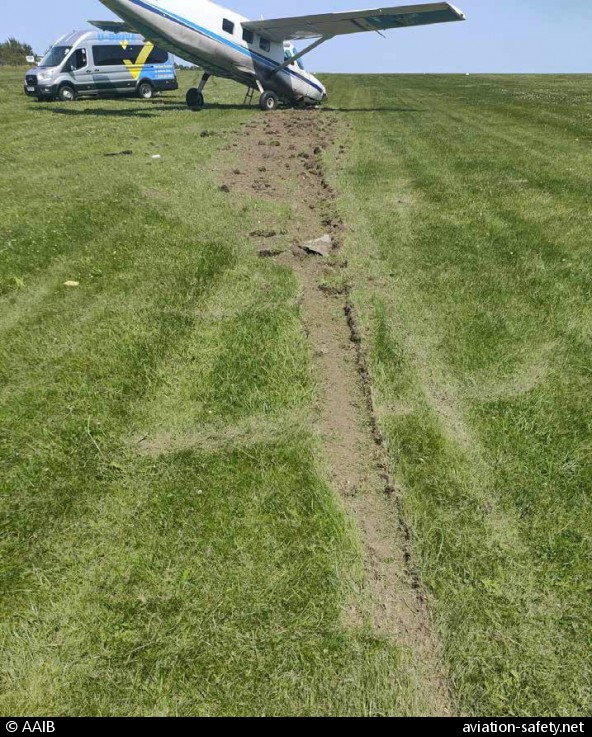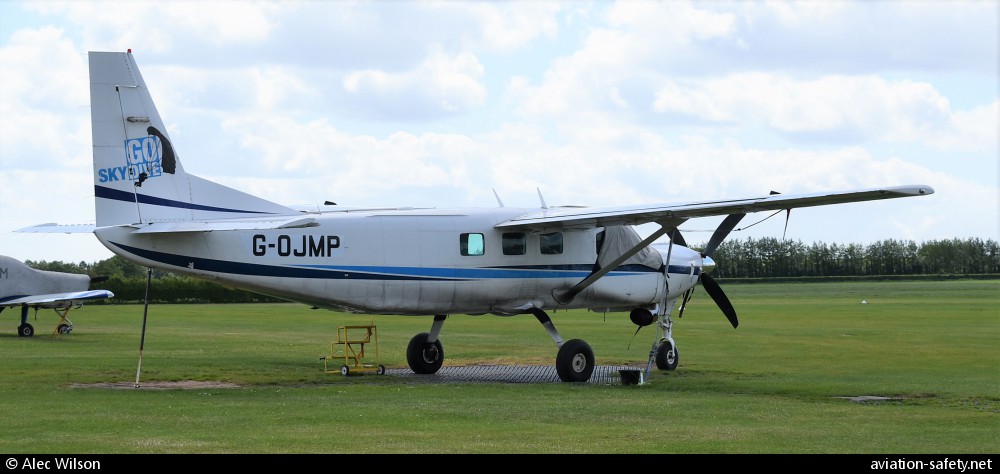
| Date: | Saturday 17 July 2021 |
| Time: | 14:39 |
| Type: |  Cessna 208B Supervan 900 |
| Owner/operator: | GoSkydive |
| Registration: | G-OJMP |
| MSN: | 208B0917 |
| Year of manufacture: | 2002 |
| Engine model: | Honeywell TPE331-12JR-704TT |
| Fatalities: | Fatalities: 0 / Occupants: 1 |
| Aircraft damage: | Substantial, written off |
| Category: | Accident |
| Location: | Old Sarum Airfield -
 United Kingdom United Kingdom
|
| Phase: | Landing |
| Nature: | Parachuting |
| Departure airport: | Old Sarum Airfield (EGLS) |
| Old Sarum Airfield (EGLS) | |
| Investigating agency: | AAIB |
| Confidence Rating: |
The pilot was scheduled to operate about 20 parachuting sorties from Old Sarum Airfield (EGLS), where the parachutists landed on the airfield. The weather was good with a wind from 030° at 9 kt and runway 06 was in use.
During these flights, the pilot wore a full-face oxygen mask and did not secure the shoulder straps on the five-point harness. He took an A5 sized metal kneeboard that he used to record details of each flight. This was kept under his backpack-style flight bag on the right seat, the flight bag being secured by routing the seats harness through the bags straps.
The first 13 flights were uneventful, with the pilot taking a rest after the eleventh flight.
During some of these earlier flights the pilot was informed, over the radio by the Drop Zone (DZ) controller, that gliders had been seen circling to the south of the airfield, but the pilot was unable to visually acquire them.
The next flight proceeded without event until the post-drop descent. Prior to the descent the DZ controller advised the pilot that gliders had now been seen to the south-west of the airfield. Mindful that he had not seen any of them, and conscious that they seemed to be moving clockwise around the airfield, he decided to fly a shorter final approach path to keep the aircraft closer to the airfield and further from the gliders, rather than potentially come into conflict with the gliders during the approach and landing. The pilot thus extended his initial descent further than on the previous flights, delaying the turn downwind, with the aim of being lower abeam the threshold of runway 06 than previously. Given the shorter final approach path, he planned to land at the beginning of runway 06, rather than slightly deeper on the flatter section, as he had done on the earlier landings.
While descending on the downwind leg, the kneeboard slipped out from under the backpack into the right footwell. The pilot initially dismissed this as a minor event and continued with the circuit, which included configuring the aircraft for landing once abeam the threshold.
However, on the final approach he became concerned that the kneeboard posed a possible hazard in the form of a potential restriction of the rudder pedals as he landed on the 18 m wide runway. At about 200 ft aal, having checked that the aircraft was on an appropriate flight path, he reached down to pick up the kneeboard from the footwell.
Upon looking up, after retrieving the kneeboard, the aircraft was a lot lower than expected. As a result, the pilot abruptly pitched the aircraft up in a bid to arrest the rate of descent (ROD). He described this as a "lifesaving manoeuvre". The aircraft touched down very hard in a field about 2 m short of the airfield boundary. It then crossed a berm that borders the airfield, at which point the nosewheel began to oscillate before collapsing. The aircraft came to rest soon thereafter within the lateral confines of the runway.
After the aircraft came to rest, the pilot secured the engine and aircraft systems and completed the normal shutdown items. The pilot exited the aircraft unassisted using the pilots side door. Once outside he noticed that the flaps were up and wondered whether he had not lowered them for the landing.
The aircraft was damaged beyond economical repair.
Conclusion:
The aircraft landed hard due to the pilot becoming distracted at a critical stage of flight by recovering his kneeboard, which had fallen into the right footwell while on the downwind leg. The primary concern for any pilot, especially during the final approach to land, is to fly the aircraft. Had he disregarded the distraction and continued to land, or performed a go-around before retrieving it, the accident is unlikely to have occurred.
Accident investigation:
 |
|
Sources:
salisburyjournal.co.uk
Location
Images:

photo (c) AAIB; Old Sarum Airfield; 17 July 2021

photo (c) Alec Wilson; Old Sarum Airfield; 10 May 2018; (CC:by-sa)
Revision history:
| Date/time | Contributor | Updates |
|---|
The Aviation Safety Network is an exclusive service provided by:


 ©2024 Flight Safety Foundation
©2024 Flight Safety Foundation